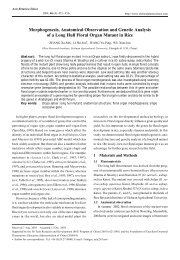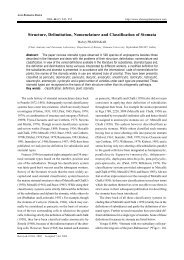Abiotic and biotic stresses and changes in the lignin ... - ResearchGate
Abiotic and biotic stresses and changes in the lignin ... - ResearchGate
Abiotic and biotic stresses and changes in the lignin ... - ResearchGate
Create successful ePaper yourself
Turn your PDF publications into a flip-book with our unique Google optimized e-Paper software.
22<br />
495<br />
496<br />
497<br />
498<br />
499<br />
500<br />
501<br />
<strong>in</strong>volved <strong>in</strong> <strong>the</strong> response to ethylene, this gene family also plays a role <strong>in</strong> <strong>the</strong><br />
methylation of monolignols dur<strong>in</strong>g <strong>the</strong> biosyn<strong>the</strong>sis of lign<strong>in</strong> (Plomion et al., 2000).<br />
Sequenced cDNAs from CW <strong>and</strong> normal wood of P<strong>in</strong>us taeda showed that <strong>the</strong><br />
genes that were most abundant <strong>in</strong> <strong>the</strong> biosyn<strong>the</strong>sis of lign<strong>in</strong> code for <strong>the</strong> enzymes PAL,<br />
C4H, OMT, 4CL, CAD, diphenol oxidase (laccase) <strong>and</strong> POD (Allona et al., 1998).<br />
The R2R3-MYB transcription factors, which have been associated with <strong>the</strong><br />
biosyn<strong>the</strong>sis of lign<strong>in</strong>, also display elevated expression <strong>in</strong> CW (Bedon et al., 2007).<br />
502<br />
503<br />
504<br />
505<br />
506<br />
507<br />
508<br />
M<strong>in</strong>eral nutrition <strong>and</strong> heavy metals<br />
Deficiency disability <strong>and</strong> abnormally high concentrations of a nutrient can both<br />
cause abnormalities <strong>in</strong> <strong>the</strong> accumulation of lign<strong>in</strong>, where this has been documented by<br />
many studies. Most of <strong>the</strong>se, however, do not <strong>in</strong>clude a study of <strong>the</strong> physiological or<br />
molecular causes of <strong>the</strong>ir f<strong>in</strong>d<strong>in</strong>gs. Recent reports have also shown that lign<strong>in</strong> content<br />
may be affected by toxic heavy metals.<br />
509<br />
510<br />
511<br />
512<br />
513<br />
514<br />
515<br />
516<br />
517<br />
Nitrogen (N): Few studies were conducted to assess <strong>the</strong> impact of fertilization with N<br />
on <strong>the</strong> properties of wood (Luo et al., 2005; Liberloo et al., 2006); most of <strong>the</strong>se<br />
<strong>in</strong>vestigated grasses used as forage for animal feed<strong>in</strong>g, show<strong>in</strong>g that lign<strong>in</strong> content was<br />
<strong>in</strong>creased by N due to elevated PAL activity (Pitre et al., 2007).<br />
Moreover, <strong>the</strong> effect of N seems to vary with <strong>the</strong> type, degree of development<br />
<strong>and</strong> tissue exam<strong>in</strong>ed. In p<strong>in</strong>e (P<strong>in</strong>us palustris) seedl<strong>in</strong>gs, high-N fertilization reduced<br />
<strong>the</strong> lign<strong>in</strong> content <strong>in</strong> roots but had no effect on <strong>the</strong> lign<strong>in</strong> concentration <strong>in</strong> aerial parts of<br />
<strong>the</strong> plant (Entry et al., 1998).







